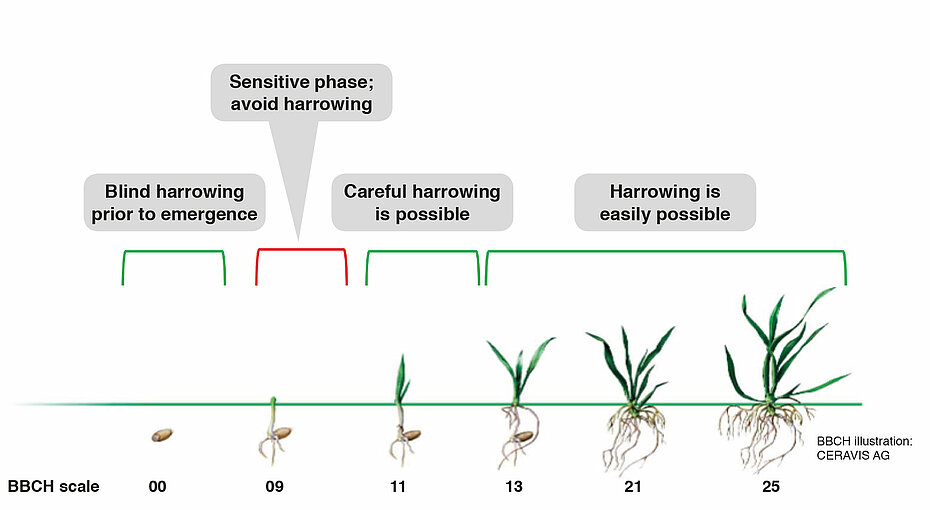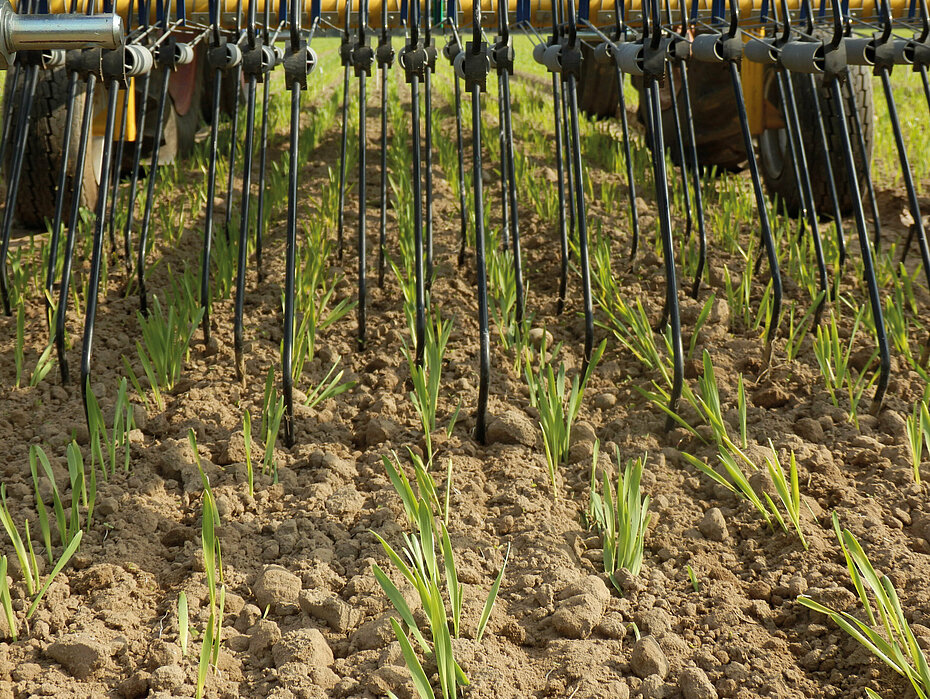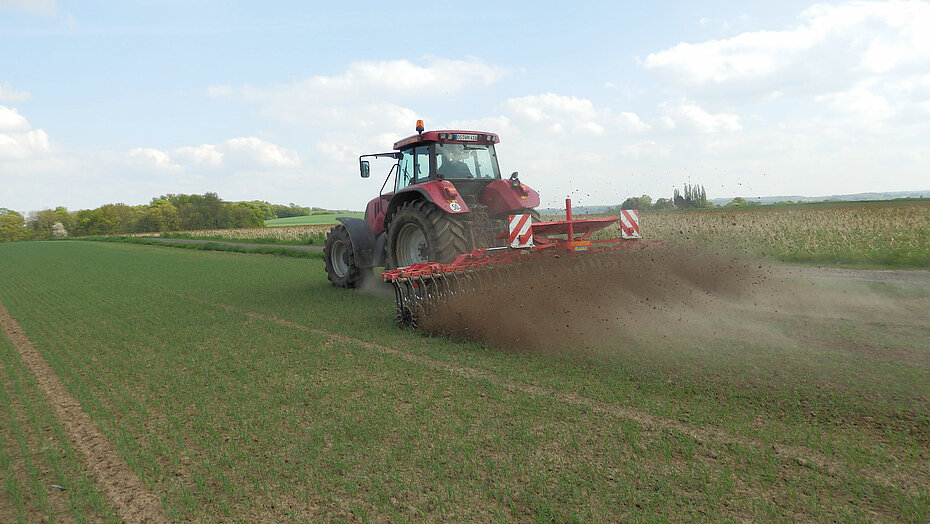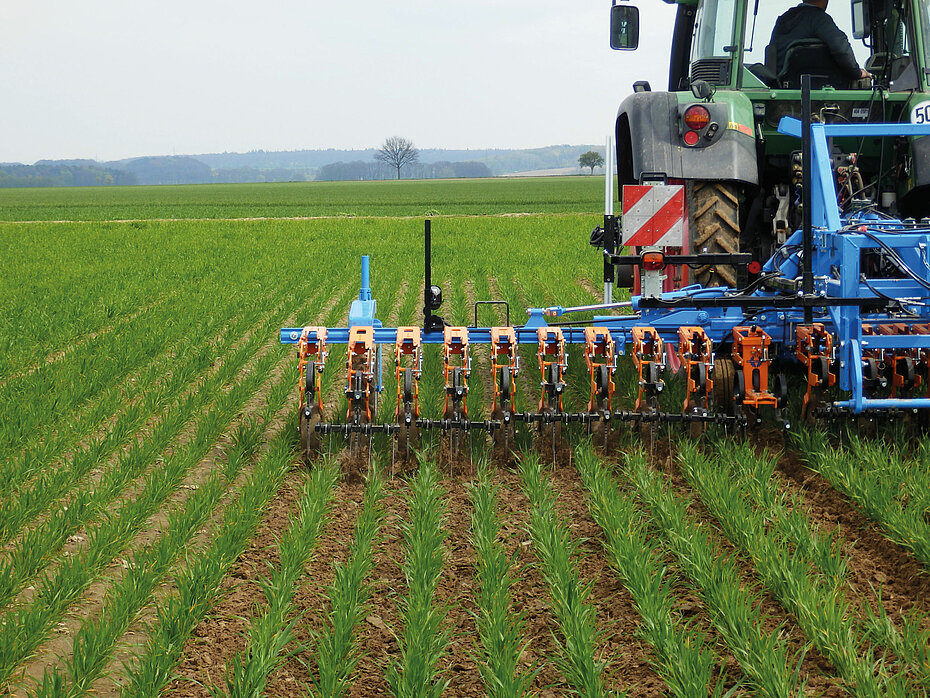1 Introduction
Mechanical weed control is a central element of successful crop growing in organic farming. And interest in mechanical weed control as an additional element of crop protection is increasing in conventional farming due to the increasing resistance of weeds to chemical active substances and because of the decline in the number of active substances that can be used.
Getting to grips with the weeds in good time during the cotyledon stage is crucial to the effectiveness of mechanical weed control. Depending on location, the optimum implementation period is severely limited due to weather and soil conditions. A farm-specific concept that is appropriate to the location therefore has to be developed. In this Expert Knowledge Series pamphlet ‘Mechanical weed control – practical concepts for cereals’, consultants show which aspects need to be focused on when developing an operational strategy, and experienced farmers provide an insight into the concepts used in their locations.
2 Crop management plans for weed control
2.1 Principles for the use of mechanical weed control technology
The success of mechanical weed control methods is influenced by numerous factors such as the weather, the soil type, the soil condition and the species of weeds as well as their development stage. The machine settings, the working speed, the scheduling of the measures and ultimately also the farmers themselves are equally crucial. Despite modern, functioning technology, it can occur that the desired control success is not always forthcoming and the anticipated work rate is not achieved.
2.1.1 Harrowing and hoeing begin before sowing
So that the harrowing and hoeing technology can operate precisely and without disturbances, the following points must be observed even prior to and during sowing:
- Attention must be paid to careful primary cultivation, seedbed preparation and sowing. A level, well re-compacted seedbed without deep tractor tracks and consistent seed depth placement are extremely important for the precise use of mechanical weed control methods.
- ‘Light’ tractors with wide tyres or two tyres as well as tyre pressure control systems should be used in soil tillage wherever possible. This enables deep ruts and harmful soil compaction to be reduced.
- Rolling after sowing may prove sensible if the seedbed is too rough. This enables the establishment of better working conditions for the subsequent mechanical methods. Rolling must be weighed up in locations that are at risk from erosion.
- In the case of primary cultivation without the use of a plough and mulching, excessively coarse and long plant residues can impede the work of harrows and coulter hoes. Plant residues can build up or the hoeing tools can become clogged. The use of mulchers, cutter rollers or cutting tools to shred the organic substance improves the performance of the mechanical control implements.
- It is crucial to coordinate the sowing and hoeing technology. To do this, the number of sowing and hoeing units must match. To ensure disturbance-free operation of the hoeing tools, the sowing units must be set to the precise row spacing and the track markers must be adjusted correctly for precise row closure. This is where the most frequent errors occur by far in practice.
- Sowing with parallel guide systems is extremely advantageous for the subsequent work with a coulter hoe. Sowing in absolutely straight rows can extensively relieve the driver, particularly in the case of coulter hoes without a steering system.
- At the edge of fields, the first row of seeds must be planted a sufficient distance away from the edge so that the outer coulter hoe unit can operate undisturbed.
2.1.2 Do not underestimate the time required
A high quality of work with a high work rate at the same time is important to many farmers. However, this can quickly result in conflicting aims in mechanical weed control methods. The basic principle is that quality of work takes precedence over the work rate.
- The time required to correctly set the implements and to regularly check the success of control and crop losses during the work is regularly underestimated. The conditions can vary extensively from field to field. Constant checks are therefore required during harrowing and hoeing and the machine settings have to be adjusted time and again. There are no generally applicable implement settings or working speed.
- When using tine harrows and coulter hoes in sensitive crops or during early stages of development, a reduced working speed of around 3 and 5 km/h often has to be implemented to prevent crop damage. This reduces the work rate.
- Only limited time slots might be available due to weather conditions. Efficient technology that is adapted to the area to be worked must therefore be provided. Using hoes or harrows early in the morning in dew-covered crops, for instance, is only recommended to a limited extent or not at all, and may only be possible as of the late afternoon at the earliest.
- Phases of unsettled weather with rainfall usually prohibit the use of mechanical methods. As a result of this, scheduled or due work cannot be completed on time, leading to the risk that the weeds develop too extensively and can then no longer be controlled in a satisfactory manner.
- Planning and scheduling the required measures necessitate continuously monitoring the weather and checking the fields as regards soil condition and weed and crop development.
- Settings for and the implementation of mechanical methods should only be undertaken by suitable, qualified staff who have good knowledge of crop production and also come equipped with calmness, experience, motivation and the ‘finesse’ needed to handle this technology.
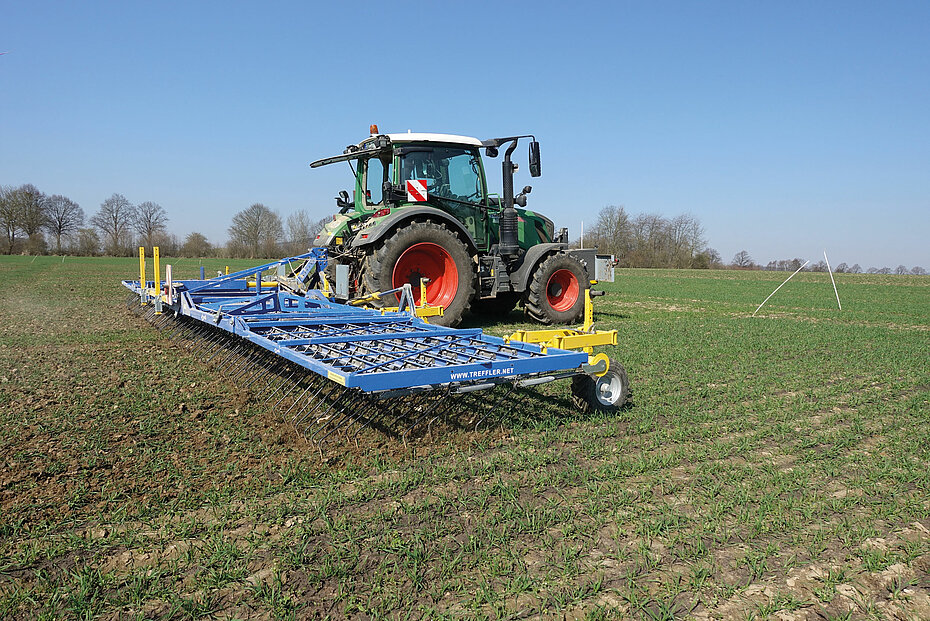
2.1.3 Principles for the use of tine harrows
- It must essentially be remembered that the controlling effect of tine harrows is based largely on uprooting and covering the still small weeds during the filament and cotyledon stages. High efficiencies of over 80 percent per pass can be achieved with the harrows in these stages. The removing and covering effect quickly decreases as the size of the weeds increases.
- Regular field inspections and precise monitoring of weather forecasts are needed to schedule the use of harrows specifically in the filament to cotyledon stages. Black grass, wind bent grass, common lamb’s quarter or knotweed species, for instance, can only be controlled most effectively up to the cotyledon stage.
- A sheet of glass or Perspex placed on the ground can help when inspecting the field. The weeds emerge earlier under the sheet and therefore make it easier to schedule harrowing measures, particularly for blind harrowing prior to emergence.
- It must also be taken into account that each soil movement encourages further weed seeds to germinate. Harrowing should therefore be carried out as shallow as possible. The following harrowing operations must be aimed at re-germinating weeds.
- The covering effect of the harrow declines significantly with larger weed plants approximately as of the second foliage leaf pair. Whilst it can be increased by increasing the working speed, this comes at the expense of crop compatibility. The removal of weed plants in advanced stages declines considerably due to their more extensive roots.
- The desired intensity of the harrow is varied via the working speed, the working depth and, depending on make, by means of either the spring pre-load or the setting angle of the tines. The harrow settings and working speed must be regularly checked on the field and adapted if necessary.
- However, crop losses of between 1 and 3 percent per harrow pass are often unavoidable depending on the crop type and size. In the event of significantly higher losses, the settings and working speed must be corrected. The possible harrowing losses should be taken into consideration during sowing by increasing the seeding rate by approximately 10 – 15 percent.
- There are no generally valid specifications for the settings or driving speed. Numerous aspects such as the make of harrow, soil type, soil condition, weed size, crop type and size, for instance, are determining factors.
- Driving very slowly in speed ranges from approximately 2 to 5 km/h is necessary during early, sensitive crop stages. Working speeds of around 5 to 10 km/h are possible in larger crop stages or when blind harrowing crops that are sown deeper.
- In order to minimise crop losses due to breaking off, care measures should only be undertaken as of approximately the late morning, when the cell pressure in the plants decreases and the plants are more elastic.
- Wherever possible, the work should also be carried out in sunny and windy weather in order to ensure that the weeds are dried quickly.
- The soil surface should be dry and free-flowing at the time of harrowing. Harrowing should be forgone in the case of excessively moist soil conditions, unsettled weather and low evaporation. Harrowing must only be undertaken when navigability is ensured, the soil is free-flowing and the weather is frost-free, dry and sunny.
- Newcomers, above all, often use harrows too often because they are concerned about excessive residual weed development. Depending on the type of crop and the development stage, excessive harrowing intensities can lead to growth impairments that impact on yields. It is also ecologically and economically nonsensical to harrow the very last dead nettle or the very last pansy from the crop. Consideration must also be given to the protection of ground-nesting birds and small game.
2.1.4 Principles for the use of coulter hoes
- Hoeing should generally be carried out as shallow as possible. However, the objective of cutting the weeds off over the entire surface must always be ensured. Excessively deep cultivation must be avoided, as seeds are increasingly encouraged to germinate on the one hand and water loss is increased on the other hand. The erosion risk factor must also be taken into account.
- A variety of different hoeing tools such as double-disc coulters, flat hoeing blades or angled blades are available for the area between the crop rows. They must be coordinated to the soil types that occur in the region. If several coulters are used between the rows, sufficient coulter overlap must be ensured to guarantee full-area hoeing.
- The objective is to guide coulters as close to the crop as possible without covering or damaging it. Protective discs or protective plates on the coulter hoe are therefore required in small crop stages. This particularly applies in the case of camera-guided coulter hoes. Higher working speeds can be achieved with these, as a result of which the risk of covering increases.
- As for harrowing, the time selected for hoeing should be the late morning or the early afternoon. Sunny weather ensures that the weeds are dried quickly.
- When using coulter hoes with camera control, it must be ensured that the tractor’s lower link side struts are locked to avoid undesired lateral movements. The lifting struts must be set so that the hoe is guided parallel to the surface of the soil and can plunge evenly into the soil. The upper links can be used to adjust the hoe horizontally or set it gently against the tip of the hoeing shares in more difficult soil conditions.
- Numerous tools are also available for controlling weeds within the crop rows. Depending on soil type, crop and development stage, these include finger hoes, roller harrows, torsion spring tines, trailing harrows and flat ridgers as well as various other ridging bodies.
2.1.5 Pseudo seedbed/pseudo tillage
Pseudo tillage’ can prove suitable if the pressure caused by weeds is expected to be high. Primary cultivation, followed directly by seedbed preparation (pseudo tillage), is carried out three to four weeks before the crop is scheduled to be sown. The subsequently emerging waves of weeds can then be controlled with harrows or other soil tillage implements that operate at shallow levels before the actual sowing. The tillage encourages other weed seeds to germinate. Depending on weed pressure, these are controlled either with a further pass or by tillage during crop sowing. The selected tillage depth should be as shallow as possible in order to not impair the moisture conditions for seed germination. Prior to tillage, however, the depth from which the weeds are germinating must be checked in order to control as many of the seedlings as possible. Knotweed species, in particular, can germinate from deeper layers of soil. Deeper tillage may then possibly be required after all. Flame weeding technology can also be used as an alternative, particularly for weeds that emerge from deeper layers of soil. This would offer the advantage that further weed seeds are not encouraged to germinate by excessively deep soil tillage and that the soil does not dry out too much. This method is comparatively expensive, however.
The necessity of a pseudo seedbed must be weighed up, because disadvantages such as an increased risk of erosion due to wind and water as well as the drying out of the seedbed have to be taken into consideration.
2.2 Cereals
Use of tine harrows
In practice, tine harrows that operate independently of rows and over the whole surface are primarily used for mechanical weed control in cereals.
Blind harrowing prior to emergence
If weed pressure occurs very early on after sowing cereals, blind harrowing prior to emergence can prove very effective. However, setting the depth of the harrows requires finesse. Taking the planting depth of the cereals into consideration, the work should be carried out as shallow as possible, i. e. down to a depth of approximately 2 cm. If feasible, the cereals should be sown slightly deeper, down to 3 to 4 cm, to be on the safe side. A flat, well re-compacted field and a consistent seed planting depth are required for the harrows to work precisely.
If drilling technology with pressure rollers without a trailing harrow is used, a shallow ridge or strip horizon is produced on the surface. Blind harrowing is advisable in this case. This enables the weeds to be effectively covered at a very early stage both on the flat ridges and also in the ridge valleys. If the strip profile is not levelled prior to emergence, the cereals would be excessively covered and damaged in the ridge valleys in the event of subsequent post-emergence harrowing.
Post-emergence harrowing
Further weed seeds are encouraged to germinate with each pass of the harrow, which is why harrowing operations must be aimed at newly germinating weeds. However, this is limited by the sensitivity of the crop to harrowing during certain stages of development. During emergence (BBCH 9 – 10), the cereals are relatively sensitive and should not be harrowed if possible, or this should only be done very carefully. Shallow harrowing at a low speed of approx. 3 – 4 km/h is possible as of the 1- to 2-leaf stage (BBCH 11 – 12). The cereals’ tolerance improves as of the trifoliate stage (BBCH 13) and harrowing is readily possible.
Harrowing winter cereals in the autumn
If winter cereals are sown early on from the end of September to roughly mid-October, harrowing may still be necessary and sensible in the autumn, particularly when black grass and wind bent grass are involved. Harrowing in the spring does not usually lead to satisfactory control results for these species, as they are then already too far developed and accordingly firmly rooted. These grasses can only be reliably controlled with harrows during the filament and 1-leaf stages. Possible harrowing periods can be very limited in the autumn or even non-existent due to weather conditions. They are essentially dependent on the weather, soil condition and weed infestation. Excessively moist soil, insufficient evaporation, persistently dew-covered crops, short days and unsettled weather prevent the use of harrows or reliable control. Harrowing must be forgone under all circumstances if the soil is too moist. Harrowing in the autumn can only prove very sensible when navigability is ensured, the soil is free-flowing and the weather is frost-free, dry and sunny. Regular field inspections and weather forecasts are elementary. Favourable harrowing time slots that should be taken advantage of can arise even in November. It is important that the cereals can regenerate sufficiently up to the end of vegetation.
Harrowing winter cereals in the spring
Winter rye puts down comparatively shallow roots. As a result, it reacts sensitively to harrowing, particularly in the spring. Thanks to its rapid growth, pronounced plant length and ground overage, rye is also outstandingly able to suppress weeds. Harrowing in the spring can therefore be forgone in the majority of cases.
Winter barley also reacts sensitively to harrowing in the spring. Intensive harrowing should therefore be avoided. Due to early sowing and the high weed pressure that is to be anticipated as a result, harrowing should therefore be carried out in the autumn if possible. One pass with the harrow in the spring is usually sufficient to loosen the soil and stimulate tillering.
Winter triticale and spelt are moderately sensitive to harrowing. Excessively frequent harrowing must be avoided in the spring and should be completed by the end of tillering. Both cereal species are comparatively good at suppressing weeds early on, as a result of which harrowing intensities can be reduced.
Winter wheat is comparatively robust and can be harrowed in the spring up to the end of the tillering phase. If the weed pressure is high, harrowing can also be carried out diagonally or transversely to the seeding direction in order to improve control success. However, harrowing in cereals should always be completed by the start of shooting.
Harrowing summer cereals
Of all of the summer cereal species, summer wheat is the most sensitive to harrowing. It regenerates comparatively slowly after harrowing. It is better not to harrow, or only to do so very carefully, prior to the trifoliate stage. In its early development stages, spring barley is more tolerant of harrowing and regenerates comparatively quickly after harrowing due to its very rapid growth. Compared to the aforementioned species, oats assume an intermediate position with respect to harrowing tolerance. Thanks to their nature, very rapid growth and plant length, oats are significantly better at suppressing weeds, which enables a reduced harrowing intensity. The principle that harrowing must be completed by the start of shooting at the latest also applies to the summer cereal species.
Less is often more
Newcomers, above all, often use harrows too often in winter cereals in the spring because they are concerned about excessive residual weed development. Excessive harrowing intensities can lead to growth impairments that impact on yields. It is also ecologically and economically nonsensical to harrow the very last dead nettle or the very last pansy from the crop. Consideration must also be given to the protection of small game, such as hares, and ground-nesting birds. This necessitates the cautious use of harrows.
Preventative measures for reducing weeds must be implemented in cereal growing in addition to mechanical measures. These include sowing later on in late autumn, which leads to a significant reduction in weed seed germination. Increased sowing rates to achieve high ground coverage early on and sowing species with a planophile leaf arrangement that grow quickly and tall act to extensively suppress weeds.
Rotary star hoes support harrows
Like tine harrows, rotary star hoes also operate independently of rows. The rotary stars are spaced approximately 10 cm apart. The rolling tools with spoon-like tips that penetrate the soil vertically achieve a crust-breaking and loosening effect. Rotary star hoes are therefore particularly advantageous on capped, crusted, loamy and clay soils. Because of the way they function, weed plants are primarily loosened and also partially uprooted. However, rotary star hoes often fail to achieve the control success of tine harrows with just one pass, but can prove to be an ideal addition to harrows.
This technology can be used well in cereals. Winter cereal crops, particularly in loamy and clay locations, can be capped or crusted in the spring, something that can quickly bring tine harrows to their limits. The use of rotary star hoes is suitable as an initial measure in the spring in this case. In a second step, the weeds can then be uprooted very well with tine harrows and exposed so that they can dry out. One positive side effect is the aeration of the soil, which can foster crop growth. The spoon-shaped tines are also far better at working farm manure in than harrows. The rotary star hoes must be driven at comparatively high speeds between 15 and 20 km/h. Despite, or precisely because of, this high speed, crop protection is surprisingly good even in sensitive early development stages. Rotary star hoes can also essentially be used in other crops such as grain legumes, sugar beets and maize. Rotary star hoes are less suitable for loose, sandy soils, as hardly any cohesive soil fragments are broken out. The machine operates too deep on repeated passes, which can result in damage and impair growth. Rotary star hoes should be equipped with support wheels to limit their depth. Some manufacturers also offer hydraulic pressure adjustment for the rotary stars in order to enable better adaptation to soil conditions.
Cereals as root crops
Cereals can also essentially be cultivated as root crops. Four-year trials conducted by the Landwirtschaftskammer Niedersachsen have shown that higher weed control success can be achieved with a hoeing system in cereals than with a pure harrow system. Hoeing is particularly advantageous on heavy clay or loamy soils on which tine harrows can quickly encounter their limits in the event of capping and drying out. However, a hoeing system can also basically be used on sandy soils. Hoeing cereals can also be supplemented well with tine harrows afterwards. As results achieved by the Landwirtschaftskammer Niedersachsen show, this enables better control success because the loosened or cut-off weeds can be freed of earth more readily and can dry out faster. The double cereal row spacing of 25 cm has proved suitable in practice. In narrow row spacings, camera- or RTK-controlled coulter hoes make hoeing work easier and relieve the driver. A cereal hoeing system offers a longer time span for hoeing, as hoeing can still be carried out up to the late shooting phase of the cereals if necessary. This can prove particularly advantageous if phases of unsettled weather have caused hoeing to be delayed.
Hoeing should generally be carried out as shallow as possible. However, the objective of cutting the weeds off over the entire surface must always be ensured. Excessively deep cultivation must be avoided, as seeds are increasingly encouraged to germinate on the one hand and a great deal of moist soil is brought to the surface on the other hand, which impacts negatively on the soil’s water balance. The risk of erosion is additionally increased.
It must be taken into consideration that the sowing and hoeing technology must be coordinated and that the process costs are comparatively high. Hoeing is usually carried out over a working width of 6 m in practice. Sowing must then also be carried out over a working width of 6 m. The process costs are very high compared to those of a harrowing system. However, individual manufacturers are now offering an interesting solution which enables cereals sown using 3-m sowing technology to be hoed over a working width of 6 m. High purchase costs also have to be taken into account in this case due to the more complex design of the moving frame combination on the hoe and the necessity of a second camera system. In turn, however, the high costs of a 6-m rotary harrow/seed drill combination would then be forgone and possibly also those of the powerful and heavy-duty tractors needed to operate it.
The above described combination of a rotary star hoe and a tine harrow represents an interesting compromise. The latest trial results from the Landwirtschaftskammer Niedersachsen show that the control success achieved by this combination in cereals is almost equally as high as that of the cereal hoeing system. Neither of the two methods revealed significant differences in yield. In addition, this system enables high work rates and lower purchase costs. Organic fertilisers can also be worked in comparatively well with rotary star hoes.
Authors
- DLG Organic Farming Committee
- Markus Mücke, Consultant Organic Crop Production, Landwirtschaftskammer Niedersachsen
- Christian Kreikenbohm, Consultant Organic Crop Production, Landwirtschaftskammer Niedersachsen
Editorial office
- Dr. Achim Schaffner, Project Manager Organic Farming, DLG e.V.
Title image: Markus Mücke, Landwirtschaftskammer Niedersachsen

